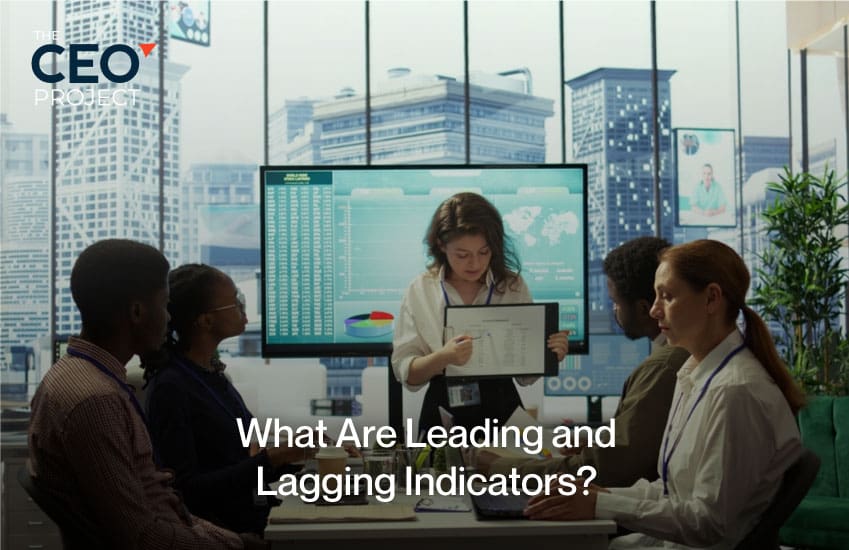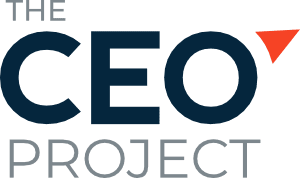Helping CEOs Anticipate Challenges Early and Adjust Accordingly
Have your business decisions ever felt one step behind reality? You aren’t alone! Many CEOs rely heavily on historical data, such as revenue, churn, and profit margins, as indicators of performance. These lagging indicators reveal what has already occurred, while leading indicators offer key insights into what might occur next.
Leading and lagging indicators aren’t simply reporting tools; they’re decision-making levers. Used correctly, leading and lagging indicators help CEOs anticipate challenges early and adjust accordingly, as well as align teams more efficiently, assisting CEOs in identifying issues before it’s too late.
In this blog post, we’ll outline what indicators truly are and how to find the appropriate ones for your business, while avoiding common measurement pitfalls.

What Are Leading and Lagging Indicators?
Leading and lagging indicators are two sides of the same coin. Leading indicators are predictive, providing CEOs with information about future performance and enabling them to make proactive decisions. Lagging indicators are used to measure the results that have already occurred, such as revenue or customer churn. CEOs use lagging indicators to confirm the outcomes, while leading indicators allow you to influence them before they happen. Strategic CEOs use both to drive the business towards success effectively.
Here is a simple breakdown of their key differences:
| Feature | Leading Indicator | Lagging Indicator |
| Timing | It predicts the future performance. | It reflects on past performance. |
| Focus | It focuses on inputs and behaviours. | It focuses on outcomes and results. |
| Actionability | It allows early course correction. | It confirmed what had already happened. |
| Example from Images | Sales calls per rep, website traffic, NPS responses, employee engagement, and new trial sign-ups | Closed deals, monthly revenue, churn rate, turnover rate, customer lifetime value |
4 Ways to Identify the Right Indicators for Your Business
Choosing the right indicators is the critical thing for tracking the success of your business because the wrong indicator can mislead the business and strategy. It starts with clarity, the CEOs must align their performance indicators with their ongoing business. The perfect mixture of leading and lagging indicators reflects your current priorities. Here is how to approach it:
- Start with Your Goals: Begin by defining your goals clearly. Metrics should tie directly to your strategic objectives.
- Map Backward From Outcomes: After defining your goals, identify the activities that drive them. This helps find the right indicator.
- Select High-Leverage Signals: Focus on inputs that have a significant impact on your results.
- Balance Both: Use both the historical data and forward-looking data. This provides a comprehensive view of progress and performance.
5 Examples of Leading vs Lagging Indicators in Different Business Areas
Every aspect of your business contains activities with quantifiable outcomes, and understanding which are leading to results can transform how you manage performance. Lagging indicators display what has already occurred, while leading indicators enable you to predict and shape future events more effectively. Here are five business functions where metrics can assist CEOs more efficiently:
- Sales & Marketing
In sales and marketing, the leading indicators will be the number of qualified leads or sales calls per representative, which indicates potential revenue generation. The lagging indicator in this field is the number of closed deals or monthly revenue, which confirms the success of marketing efforts.
- Customer Support
Monitor customer satisfaction survey participation, as this is a leading indicator that points to signals of customer experience. Churn rate or support ticket backlog are the lagging indicators that reflect the actual outcomes.
- Operations
On-time delivery rate and inventory accuracy are leading indicators of operational efficiency. The lagging indicators for operations are product defects or order fulfillment delays that surface issues that can impact results.
- People and Culture
Insights into the team’s health and development are revealed through employee engagement scores and training completion rates. At the same time, the turnover rate or time-to-fill open roles are lagging indicators that hint at the cultural or leadership gaps.
- Finance
Pipeline velocity or expense-to-revenue ratio can provide early indicators of financial health. On the other hand, profit margins, cash flow, or customer lifetime value serve as classic lagging indicators that confirm outcomes post factum.
Common Mistakes to Avoid as a CEO
Even experienced CEOs can get trapped when it comes to using metrics to guide strategy. Clarity, focus, and relevance are required to differentiate between a dashboard that drives growth and one that distracts. To lead effectively, your indicators must be more than just data points; they should support informed decisions, drive accountability, and align with long-term goals.
Here are three mistakes that smart CEOs must avoid:
- Don’t Track Vanity Metrics, Do Track Behavior-Driving Indicators: Don’t get caught up in surface-level numbers like social media followers or page views; instead, focus on behaviors and outcomes that drive results.
- Don’t Rely Only On Backward-Looking Data, Do Forecast With Forward-Looking Metrics: Prioritize leading indicators over lagging indicators as they help you course-correct before issues escalate.
- Don’t Overwhelm With 20+ KPIs, Do Focus on a Critical Few: A cluttered dashboard with lots of indicators creates confusion. Choose only those metrics that align with your strategic objectives.
Ready To Turn Metrics Into Momentum? Lead with Insight, Not Just Oversight!
As CEO, your power lies not only in making decisions but in making informed ones. Understanding leading and lagging indicators enables you to anticipate challenges early, steer your strategy effectively, and build an organization that is proactive rather than reactive. Metrics don’t just measure performance; they also shape it.
Are you looking to stop guessing and direct your business with clarity? Enhancing your KPI strategy could be the key. At The CEO Project, we help high-performing CEOs design smarter dashboards, focusing on what matters, and scale organizations with precision. Join our group and learn about the ways we can use to refine both data and direction!
FAQs
- What is an example of a lead vs lag indicator?
The example of both indicators in sales is that the number of qualified leads is a leading indicator, while the number of closed leads is a lagging indicator, as it hints at revenue.
- What is the primary advantage of lagging indicators over leading indicators?
Lagging indicators are reliable because they show actual performance and outcomes with solid data.
- Can a KPI be both leading and lagging?
Yes, A KPI can be both, depending on the context. Take the example of customer satisfaction. This can be a lagging indicator for support performance and a leading indicator for future retention.
- What are the advantages of leading indicators over lagging indicators?
Leading indicators help in making forecasts and allow CEOs to anticipate issues and adjust their strategy.






